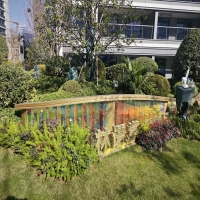Welcome to the website for landscape facilities products and knowledge.
How does the table’s design handle the placement of outdoor science or nature exploration tools?
Outdoor science tables represent a revolutionary approach to experiential learning, specifically engineered to accommodate nature exploration tools with remarkable efficiency. The fundamental design philosophy centers on creating dedicated zones that maintain organization while encouraging hands-on discovery. Unlike conventional tables, these specialized stations incorporate waterproof compartments sized precisely for magnifying glasses, specimen containers, and collection jars, preventing tools from rolling off or becoming misplaced during investigative activities.
The integration of tool holders along the table's perimeter represents a particularly innovative feature. These strategically placed clips and slots securely fasten items such as tweezers, droppers, and measuring tapes, ensuring essential instruments remain accessible yet protected. Below the main surface, pull-out trays with divided sections offer systematic storage for smaller items like rock samples, leaves, and insect observation boxes, while overhead racks provide hanging space for nets and magnifier stands.
Surface materials deserve special attention – typically composed of weather-resistant polymer or treated wood, these tables feature non-slip textures that prevent tools from shifting during use. Some advanced designs incorporate built-in water channels and drainage systems, allowing for messy experiments involving water or soil without compromising tool integrity. Recessed areas serve as temporary habitats for living specimens, while integrated measurement markings along the edges facilitate immediate data collection.
The height-adjustable legs found on many models accommodate different age groups, ensuring comfortable access to tools regardless of the user's stature. Additionally, some designs incorporate rotating central organizers that bring tools within easy reach from all sides, promoting collaborative investigation. The strategic placement of darker-colored borders helps contain small items within the work area, reducing loss and maintaining focus on the scientific process.
This thoughtful approach to tool placement transforms random exploration into structured scientific inquiry, where every instrument has its designated space yet remains instantly available. The elimination of time spent searching for misplaced tools means more continuous engagement with the natural world, fostering deeper curiosity and more meaningful discoveries in outdoor educational settings.
Related search:

Recommendation
Metal and acrylic color-changing combined curtain wall for large-scale public landscape facilities